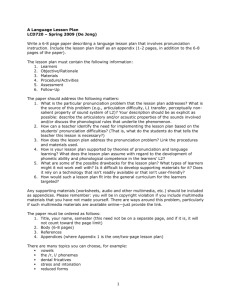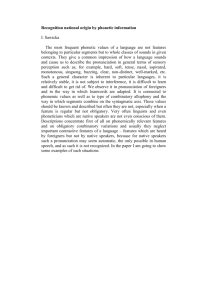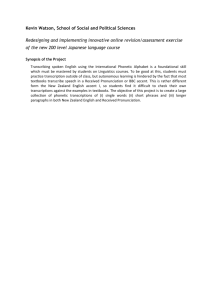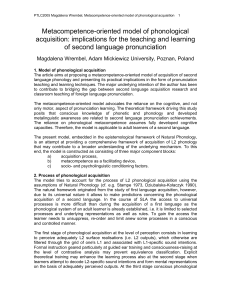Phonological "know that" or "know how"?
advertisement
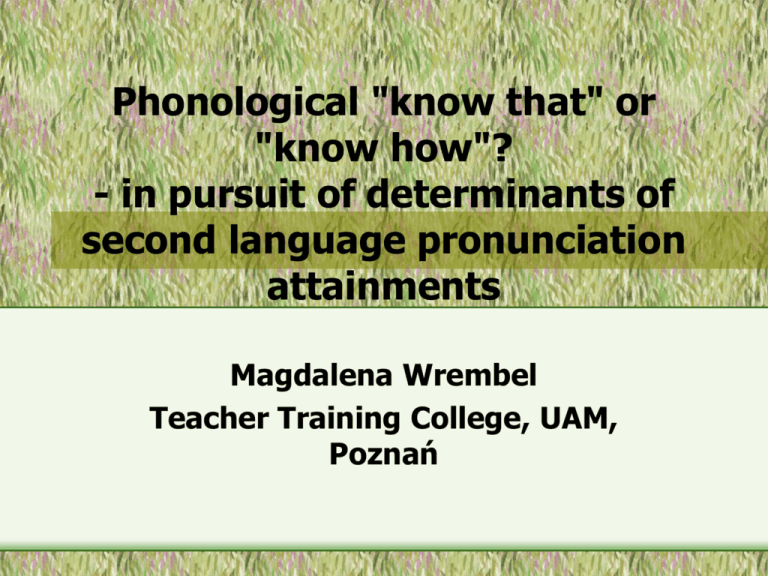
Phonological "know that" or "know how"? - in pursuit of determinants of second language pronunciation attainments Magdalena Wrembel Teacher Training College, UAM, Poznań Introduction The paper reports on the results of a specially designed training programme; aims at investigating the effectiveness of explicit instruction and the role of theoretical training; expects to demonstrate patterns of change in pronunciation performance on pre-test / post-test measures; seeks to verify the hypothesis that conscious knowledge leads to the formation of mental representations; attempts to account for other variables related to L2 pronunciation acquisition. 2 Outline of the presentation • • • • • • Background studies Theoretical framework Rationale and goals Experimental design Results of the study Conclusions implications for pronunciation pedagogy 3 Studies on predictors of success • • • • • • • Purcell & Suter 1980 - futility of instruction Dickerson 1983 - effectiveness of phonological rules Champagne et al. 1988 - perceptual training Dziubalska-Kołaczyk 1990 -formal > natural setting Elliott 1995 - formal instruction Gayoso et al. 1999 - meta & phonological training Stasiak & Szpyra-Kozłowska 2003 - aural exposure & drilling vs. phonetic instruction • Waniek-Klimczak 2004 - phonetic universals • Baran 2004 - field independence 4 "Know how" or "know that" ? • RATIONALE: need for investigations into the effectiveness of pronunciation instruction • ASSUMPTION: pronunciation improves through gradual monitoring of an acquired system based on metacompetence • METACOMPETENCE: conscious knowledge of the grammar of a language (e.g. phon. & phon. - metaphonological competence) • FRAMEWORK: NATURAL PHONOLOGY – (D. Stampe & P. Donegan, W. U. Dressler) 5 Model of acquisition of L2 phonology acc. to Nat. Phon. • L2 learner - reduced phonological system • only selected processes available • confronted with L2 subconsciously applies L1 processes • IF processes L1 = L2 positive transfer • IF L1 L2 L1 interference • (lacking L2 processes have to be learnt consciously as rules) explicit instruction, metacompetence ! • Successful access to phonological processes conditioned by sociological, psychological & linguistic factors 6 Goals of the study To find correlation between L2 pronunciation attainment & theoretical training "know that" > "know how" To investigate other potential determinants of pronunciation success 7 Experimental design • • • • Participants: 33 first year students Timing: Oct 2002 - Feb 2003 Course: 50 hours, 15 weeks Groups: – control – experimental practical training practical + theoretical instruction • Hypothesis: Metacompetence as a determinant of L2 pronunciation success 8 Participants - control factors analysis • • • • • • • • Age: 19 - 25 (M: 20;6) Length of formal exposure: 5 - 13 (M: 9) First contact with English: 5 - 16 (M: 10;6) Stay in UK / US - 35% Lack of previous phonetic training Formal setting of instruction Comparable language proficiency Positive attitude and high motivation (PAI) 9 Instruments and test administration • Perception tests: – Oxford Placement Listening Test (Allan 1992) – Vowel Recognition Test (VRT) • Production tests: – LIST - reading a list of 50 words or phrases – DIAL - reading a dialogue in pairs – SPEECH - extemporaneously produced narrative 10 Instruments and test administration (2) Task-related variability Digitally recorded speech samples – CoolEdit96 (22kHz, 16-bit resolution) 3 judge listeners – interrater reliability (.93 - .67) 11 Treatment - course content & procedures • Practical training - exposure & imitation: – auditory sensitisation and discrimination – articulatory warm-up – phonetic drills – dialogue reading and performing – speeches and presentations – teacher correction (audio, visual & kinaesthetic feedback) 12 Treatment - course content & procedures (2) • Theoretical training: – articulatory descriptions – C & V systems classification – contrastive analysis – theoretical readings and discussions – visual aids reinforcement – meta-awareness raising 13 Cycles of practice modes (cf. Morley 1991) • Imitative (dependent) speech practice – pronunciation drills with a model • Rehearsed (guided) speech practice – oral script reading & pre-prepared presentations • Independent practice – spontaneous presentations, self-generated content 14 PRONUNCIATION PERFORMANCE - experimental group • • • • • TOTAL improvement by 18 % LIST by 42 % DIAL by 20 % SPEECH by 8 % PERC by 3 % TESTS S.D. Mean S.D. Chng. Chng. LIST Pre Post DIAL Pre Post SPEE Pre Post PERC Pre 13.67 36.53 4.33 6.60 4.60 5.80 80.15 t p 7.32 7.21 -22.87 3.44 -25.74 .00 1.76 1.76 -2.27 .80 -10.99 .00 1.18 1.21 -1.20 .68 -6.87 .00 3.36 Post 83.46 4.61 -3.31 4.59 -2.6 15 .02 PRONUNCIATION PERFORMANCE - control group TEST S.D. Pre Post Pre Post 19.75 35.69 5.38 6.69 8.13 6.29 -15.94 5.40 -11.81 1.78 1.62 -1.31 .95 -5.55 Pre Post PERC Pre Post 5.63 6.50 81.31 85.75 1.36 1.21 4.38 5.80 LIST • • • • • TOTAL improvement by 13 % LIST by 26 % DIAL by 16 % SPEECH by 6 % PERC by 4.4 % S.D. Chng. Chng. Mean DIAL SPEE t p .00 .00 -0.88 .62 -5.65 .00 -4.44 4.16 -4.26 .00 16 PRETEST / POSTTEST CHANGE - EXPERIMENTAL VS. CONTROL Table 3 T-test - Experimental vs. control group Variable LIST DIALOGUE SPEECH PERCEPTION VRT * Control Group N S.D. Mean 16 4.59 13.09 16 0.52 1.56 16 0.78 0.59 16 4.16 4.44 16 6.22 52,13 * VRT – Vowel Recognition Test Experimental Group N S.D. Mean 17 3.28 21.05 17 0.5 2.03 17 0.59 0.79 17 5 2.59 17 12.71 60.56 t -5.81 -2.63 -0.84 1.15 -2.4 df 31 31 31 31 31 p .000 .01 .409 .259 .028 17 Correlational analysis of variables 18 Implications for further research • To replicate the experiment on: – a larger sample – a more heterogeneous sample • To measure the effectiveness of innovative techniques • To enhance instruments for measuring perception 19 Conclusions • Explicit pronunciation training: improvement in overall phonetic accuracy phonological metacompetence - determinant of success • Conscious knowledge of phonological processes facilitates: formation of mental representations self-organisation of the new phonological system • Implications for foreign language learning: metalinguistic awareness raising supplementing practical phonetic training with theoretical instruction in phonetics and phonology20



